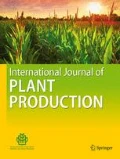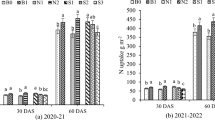Abstract
Conservation tillage can drastically influence the environment by conserving soil due to enhancing soil structure and quality, thereby maintaining stable crop productivity and quality. To evaluate the effects of tillage practices, wheat residue management, and rate of nitrogen fertilization on soil and sweet corn quality, a 2-year (2014–2015) field study was conducted at the School of Agriculture farm, Shiraz University, Shiraz, Iran. Treatments consisted of three tillage systems including conventional (CT), reduced (RT), and no tillage (NT) as main plots, four N rates (0, 69, 138, and 207 kg N ha−1) as sub plots, and wheat residue management, removed versus retained, as sub–sub plots. Increasing N rates slightly increased ECe but not to the detrimental levels for crop or soil health. Soil pH was buffered due to the calcareous nature of the experimental soil. Soil organic carbon and total nitrogen were higher under RT and NT than CT, although the changes were considerably low. Soil bulk density was higher under NT treatment, which resulted in lower marketable yield after 2 years probably due to the limitations in nutrient uptake and N immobilization and applying high rates of N could reduce or eliminate N immobilization and limitations in nutrient uptake, resulted in comparable yield to CT. The higher N rates increased kernel protein content but reduced soluble solids of kernels (brix). Reduced tillage was slightly superior to the other two tillage practices in case of soil and kernel quality and marketable yield, while applying high N rate (207 kg N ha−1) to NT practice could compensate yield reduction during the transition from CT to NT practice.








Similar content being viewed by others
References
Afzalinia, S., & Zabihi, J. (2014). Soil compaction variation during corn growing season under conservation tillage. Soil and Tillage Research, 137, 1–6. https://doi.org/10.1016/j.still.2013.11.003.
Alijani, K., Bahrani, M. J., & Kazemeini, S. A. (2012). Short-term responses of soil and wheat yield to tillage, corn residue management and nitrogen fertilization. Soil and Tillage Research, 124, 78–82. https://doi.org/10.1016/j.still.2012.05.005.
Alijani, K., Bahrani, M. J., & Kazemeini, S. A. (2019). Is it necessary to adjust nitrogen recommendations for tillage and wheat residue management in irrigated sweet corn? Archives of Agronomy and Soil Science, 65(14), 1984–1997. https://doi.org/10.1080/03650340.2019.1587162.
Anonymous. (1994). Determination of crude protein in cereals and cereal products for food and for feed. International Association for Cereal Science and Technology, Standard Methods No. 105/2, Vienna, Austria.
Bahrani, M. J., Raufat, M. H., & Ghadiri, H. (2007). Influence of wheat residue management on irrigated corn grain production in a reduced tillage system. Soil and Tillage Research, 94, 305–309. https://doi.org/10.1016/j.still.2006.08.004.
Bremner, J. M. (1996). Nitrogen-total. In D. L. Sparks et al. (Eds.), Methods of soil analysis, part 3: Chemical methods (pp. 1085–112). SSSA Book Series No. 5.3. SSSA, Madison, WI. https://doi.org/10.2136/sssabookser5.3.c37.
Chen, B., Liu, E., Tian, Q., Yan, C., & Zhang, Y. (2014). Soil nitrogen dynamics and crop residues: A review. Agronomy for Sustainable Development, 34, 429–442. https://doi.org/10.1007/s13593-014-0207-8.
Dikgwatlhe, S. B., Chen, Z.-D., Lal, R., Zhang, H., & Chen, F. (2014). Changes in soil organic carbon and nitrogen as affected by tillage and residue management under wheat-maize cropping system in the North China Plain. Soil and Tillage Research, 144, 110–118. https://doi.org/10.1016/j.still.2014.07.014.
Du, Z., Ren, T., & Hu, C. (2010). Tillage and residue removal effects on soil carbon and nitrogen storage in the North China Plain. Soil Science Society of America Journal, 74, 196–202. https://doi.org/10.2136/sssaj2009.0048.
FAO. (2011). Soil health. Save and grow, a policymaker’s guide to the sustainable intensification of smallholder crop production. Rome: FAO.
Feng, Y., Ning, T., Li, Z., Han, B., Han, H., Li, Y., et al. (2014). Effects of tillage practices and rate of nitrogen fertilization on crop yield and soil carbon and nitrogen. Plant Soil and Environment, 60, 100–104. https://doi.org/10.17221/820/2013-PSE.
Grossman, R. B., & Reinsch, T. G. (2002). Bulk density and linear extensibility. In J. H. Dane, & C. G. Topp (Eds.), Methods of soil analysis, part 4: Physical methods (pp. 201–228). SSSA Book Series No. 5.4, SSSA, Madison, WI. https://doi.org/10.2136/sssabookser5.4.c9.
Hajabbasi, M. A. (2005). Soil physical properties due to different tillage systems in dryland regions of northwestern Iran. Caspian Journal of Environmental Sciences, 3(2), 89–97.
Halvorson, A. D., & Jantalia, C. P. (2011). Nitrogen fertilization effects on irrigated no-till corn production and soil carbon and nitrogen. Agronomy Journal, 103, 1423–1431. https://doi.org/10.2134/agronj2011.0102.
Harrill, R. (1998). Using a refractometer to test the quality of fruits and vegetables. Keedysville, MD: Pineknoll Publishing.
Khan, S. A., Mulvaney, R. L., Ellsworth, T. R., & Boast, C. W. (2007). The myth of nitrogen fertilization for soil carbon sequestration. Journal of Environmental Quality, 36, 1821. https://doi.org/10.2134/jeq2007.0099.
Lazcano, C., Revilla, P., Malvar, R. A., & Domínguez, J. (2011). Yield and fruit quality of four sweet corn hybrids (Zea mays) under conventional and integrated fertilization with vermicompost. Journal of the Science of Food and Agriculture, 91, 1244–1253. https://doi.org/10.1002/jsfa.4306.
Liebig, M. A., Varvel, G. E., Doran, J. W., & Wienhold, B. J. (2002). Crop sequence and nitrogen fertilization effects on soil properties in the Western Corn Belt. Soil Science Society of America Journal, 66, 596–601. https://doi.org/10.2136/sssaj2002.5960.
López-Fando, C., & Pardo, M. T. (2009). Changes in soil chemical characteristics with different tillage practices in a semi-arid environment. Soil and Tillage Research, 104, 278–284. https://doi.org/10.1016/j.still.2009.03.005.
Lundy, M. E., Pittelkow, C. M., Linquist, B. A., Liang, X., van Groenigen, K. J., Lee, J., et al. (2015). Nitrogen fertilization reduces yield declines following no-till adoption. Field Crops Research, 183, 204–210. https://doi.org/10.1016/j.fcr.2015.07.023.
Ma, B. L., Subedi, K. D., & Zhang, T. Q. (2007). Pre-sidedress nitrate test and other crop-based indicators for fresh market and processing sweet corn. Agronomy Journal, 99, 174–183. https://doi.org/10.2134/agronj2006.0028.
Maltas, A., Charles, R., Jeangros, B., & Sinaj, S. (2013). Effect of organic fertilizers and reduced-tillage on soil properties, crop nitrogen response and crop yield: Results of a 12-year experiment in Changins, Switzerland. Soil and Tillage Research, 126, 11–18. https://doi.org/10.1016/j.still.2012.07.012.
Mohajeri, F. (2010). Influence of different amount of wheat residues and nitrogen on morphophysiological and agronomic characteristics and weeds in sunflower (Helianthus annuus) under three tillage systems. PhD dissertation, Shiraz University, Iran (in Farsi with English abstract).
Nelson, D. W., & Sommers, L. E. (1996). Total carbon, organic carbon, and organic matter. In D. L. Sparks, et al. (Eds.), Methods of soil analysis, part 3: Chemical methods (pp. 961–1010). SSSA Book Series No. 5.3, SSSA, Madison, WI. https://doi.org/10.2136/sssabookser5.3.c34.
Oktem, A., Oktem, A. G., & Emeklier, H. Y. (2010). Effect of nitrogen on yield and some quality parameters of sweet corn. Communications in Soil Science and Plant Analysis, 41, 832–847. https://doi.org/10.1080/00103621003592358.
Rhoades, J. D. (1996). Salinity: Electrical conductivity and total dissolved solids. In D. L. Sparks, et al. (Eds.), Methods of soil analysis, part 3: Chemical methods (pp. 417–435). SSSA Book Series No. 5.3, SSSA, Madison, WI. https://doi.org/10.2136/sssabookser5.3.c14.
Sarikhani Khorami, S., Kazemeini, S. A., Afzalinia, S., & Gathala, M. K. (2018). Changes in soil properties and productivity under different tillage practices and wheat genotypes: A short-term study in Iran. Sustainability, 10, 3273. https://doi.org/10.3390/su10093273.
SAS Institute. (2003). SAS users’ guide. Cary, NC: SAS Institute.
Schillinger, W. F., Young, D. L., Kennedy, A. C., & Paulitz, T. C. (2010). Diverse no-till irrigated crop rotations instead of burning and plowing continuous wheat. Field Crops Research, 115, 39–49. https://doi.org/10.1016/j.fcr.2009.10.001.
Shah, A. N., Tanveer, M., Shahzad, B., Yang, G., Fahad, S., Ali, S., et al. (2017). Soil compaction effects on soil health and crop productivity: An overview. Environmental Science and Pollution Research. https://doi.org/10.1007/s11356-017-8421-y.
Shen, W., Lin, X., Shi, W., Min, J., Gao, N., Zhang, H., et al. (2010). Higher rates of nitrogen fertilization decrease soil enzyme activities, microbial functional diversity and nitrification capacity in a Chinese polytunnel greenhouse vegetable land. Plant and Soil, 337, 137–150. https://doi.org/10.1007/s11104-010-0511-2.
Sithole, N. J., & Magwaza, L. S. (2019). Long-term changes of soil chemical characteristics and maize yield in no-till conservation agriculture in a semi-arid environment of South Africa. Soil and Tillage Research, 194, 104317. https://doi.org/10.1016/j.still.2019.104317.
Sithole, N. J., Magwaza, L. S., & Mafongoya, P. L. (2016). Conservation agriculture and its impact on soil quality and maize yield: A South African perspective. Soil and Tillage Research, 162, 55–67. https://doi.org/10.1016/j.still.2016.04.014.
Smith, J. L., & Doran, J. W. (1996). Measurement and use of pH and electrical conductivity for soil quality analysis. In J. W. Doran, & A. J. Jones (Eds.), Methods for assessing soil quality (pp. 169–186). SSSA Special Publication No. 49, SSSA, Madison, WI.
Thomas, G. W. (1996). Soil pH and soil acidity. In D. L. Sparks, et al. (Eds.). Methods of soil analysis, part 3: Chemical methods (pp. 475–490). SSSA Book Series No. 5.3, SSSA, Madison, WI. https://doi.org/10.2136/sssabookser5.3.c16.
USDA. (1994). United States standards for grades of sweet corn. In Shipping point and market inspection instructions for sweet corn. Retrieved March, 2009, from http://www.ams.usda.gov/AMSv1.0/getfile?dDocName=STELPRDC5050261.
Ussiri, D. A. N., & Lal, R. (2009). Long-term tillage effects on soil carbon storage and carbon dioxide emissions in continuous corn cropping system from an alfisol in Ohio. Soil and Tillage Research, 104, 39–47. https://doi.org/10.1016/j.still.2008.11.008.
Van Den Bossche, A., De Bolle, S., De Neve, S., & Hofman, G. (2009). Effect of tillage intensity on N mineralization of different crop residues in a temperate climate. Soil and Tillage Research, 103, 316–324. https://doi.org/10.1016/j.still.2008.10.019.
Wong, A. D., Juvik, J. A., Breeden, D. C., & Swiader, J. M. (1994). Shrunken2 sweet corn yield and the chemical components of quality. Journal of the American Society for Horticultural Science, 119(4), 747–755.
Wu, P., Dai, Q., & Tao, Q. (1993). Effect of fertilizer rates on the growth, yield, and kernel composition of sweet corn. Communications in Soil Science and Plant Analysis, 24(3–4), 237–253. https://doi.org/10.1080/00103629309368795.
Xue, J., Ren, A., Li, H., Gao, Z., & Du, T. (2017). Soil physical properties response to tillage practices during summer fallow of dryland winter wheat field on the Loess Plateau. Environmental Science and Pollution Research. https://doi.org/10.1007/s11356-017-0684-9.
Zhang, H., Lal, R., Zhao, X., Xue, J., & Chen, F. (2014). Opportunities and challenges of soil carbon sequestration by conservation agriculture in China. Advances in Agronomy, 124, 1–36. https://doi.org/10.1016/B978-0-12-8001387.00001-2.
Funding
Research financed by the Ministry of Science, Research and Technology of Iran as the part of PhD dissertation of Department of Plant Production and Genetics, Shiraz University, Shiraz, Iran.
Author information
Authors and Affiliations
Corresponding author
Ethics declarations
Conflict of interest
The authors declared that they have no conflicts of interest to this work.
Rights and permissions
About this article
Cite this article
Alijani, K., Bahrani, M.J., Kazemeini, S.A. et al. Soil and Sweet Corn Quality Responses to Tillage, Residue, and Nitrogen Management in Southern Iran. Int. J. Plant Prod. 15, 139–150 (2021). https://doi.org/10.1007/s42106-020-00127-z
Received:
Accepted:
Published:
Issue Date:
DOI: https://doi.org/10.1007/s42106-020-00127-z




